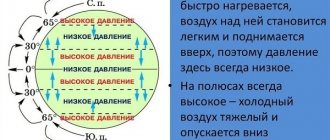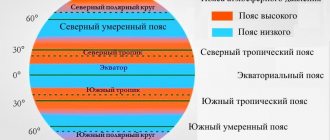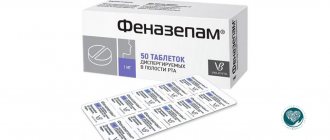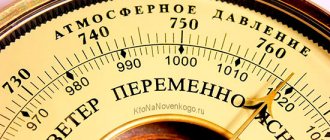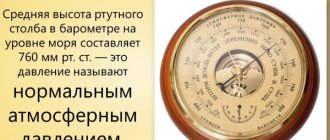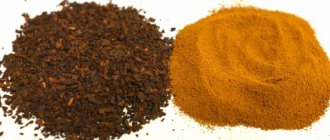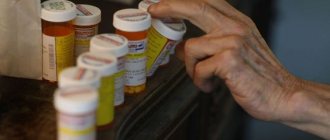Breathing under special conditions
Special conditions mean breathing at low or high atmospheric pressure.
High blood pressure. Increased pressure is created in a special device in which a person works under water. (Every 10 m of depth creates a pressure of 1 atm.) For example, during the construction of bridges and piers, a special bell is lowered under water - a caisson, the shaft of which is located above the surface of the water and communicates with the decompression chamber. The entire system is hermetically sealed. To prevent water from flowing under the bell, increased pressure is created in the caisson. If the bell is lowered to a depth of 100 m, then the pressure should be at least 11 atm. At the same time, a large amount of gases are dissolved in the blood and tissues of working people, of which nitrogen is especially dangerous. With a rapid transition from high pressure to normal pressure, gases are released and a large number of gas bubbles are formed in the fluids and tissues of the body, just like when uncorking a bottle of sparkling water. Oxygen bubbles are quickly absorbed by tissues. Nitrogen gas is not used by the body. The resulting nitrogen bubbles clog the capillaries, which impairs blood circulation. As the pressure in the decompression chamber gradually decreases, nitrogen is expelled through the lungs to the outside. When a person rises from the bell to the surface, the pressure in the above-water airlock (decompression) chamber slowly decreases over several hours.
The effect of low pressure. At sea level the pressure is 760 mmHg. Art., i.e. 1 atm. In the upper layers of the atmosphere the pressure is lower and the partial pressure of oxygen is correspondingly lower. At an altitude of 3000 m, atmospheric pressure decreases by 1/3 and is 510 mm Hg. Art., 6000 m - by 1/2 (380 mm Hg) and at an altitude of 9000 m it decreases by 2/3 of the atmosphere (200 mm Hg).
At an altitude of up to 3000 m, a person feels quite satisfactory. His lung ventilation increases, blood circulation accelerates, and after some time in the mountains his hemoglobin content increases. Thus, a person adapts to low blood pressure. When rising to an altitude of 4000 - 6000 m, hypoxemia appears - a decrease in oxygen tension in the blood and disorders of physiological functions occur, called mountain sickness. Mountain sickness manifests itself as shortness of breath, cyanosis, attacks of suffocation, palpitations, nosebleeds, dizziness, and vomiting.
Hypoxia - insufficient supply of oxygen to tissues - can occur when there is a lack of oxygen in the inhaled air (for example, in the mountains), anemia - a decrease in hemoglobin content in the blood, and carbon monoxide (CO) poisoning, when hemoglobin loses the ability to transport oxygen.
Asphyxia (suffocation) is a condition when not only the delivery of oxygen stops, but also the release of carbon dioxide. It occurs when breathing stops due to a foreign body entering the trachea, swelling of the glottis, etc.
Artificial respiration. If breathing stops due to any reason: anesthesia, electric current, drowning, if the heart continues to beat, perform artificial respiration or artificial ventilation. Artificial respiration is carried out either using special devices, or using the mouth-to-mouth or mouth-to-nose method. Sometimes it is possible to restore the activity of the respiratory center and, consequently, natural breathing.
Protective breathing reflexes - coughing, sneezing. When irritants impact the mucous membranes of the airways, for example, when foreign particles enter the trachea or mucus accumulates in the upper part of the larynx, a person reflexively exhales a short, deep breath - a cough impulse, in which foreign bodies are removed with a strong stream of air.
When the nasal mucosa is irritated by dust particles, a reflex action occurs - sneezing. It consists of an initial deep breath, and then a sharp short exhalation. In addition, sneezing can occur as a signal of uneven cooling, for example when bare feet come into contact with a cold floor.
Medical Internet conferences
The influence of atmospheric pressure on human health
Kushnereva T.M.
Scientific supervisor: academician biology Badak I.I.
Municipal educational institution Secondary School No. 8 of Novouzensk
The influence of atmospheric pressure on a person is inevitable and most often affects well-being; this effect is especially noticeable on people suffering from diseases of the cardiovascular system. Such people who feel discomfort from magnetic storms and fluctuations in weather conditions are called sensitive.
Atmospheric pressure is the pressure of atmospheric air on objects in it and on the earth's surface. For a person to feel comfortable, the atmospheric pressure must be 750 mmHg; this figure is called normal atmospheric pressure. If the value changes by more than 10 units, both up and down, the human body reacts with a general deterioration in well-being.
The danger to humans lies not only in fluctuations in atmospheric pressure, but also in one’s own blood pressure. A person may not be aware of the problem of high blood pressure, exposing himself to the risk of cardiovascular accidents (stroke or heart attack), which rank first in the structure of mortality. The relevance of the work is determined by the need to prevent hypertensive crises and reduce the risk of organic damage to large vessels.
The purpose of this study:
-to study the effect of atmospheric pressure on patients with arterial hypertension of the therapeutic department of the Novouzenskaya Central District Hospital
— establish the relationship between fluctuations in atmospheric pressure and the well-being of patients, changes in blood pressure levels.
Research objectives:
- analyze literature and other sources on the issue under consideration
— find out what effect atmospheric pressure has on human well-being and health.
Materials and methods: an examination was carried out, complaints were collected, and blood pressure levels were measured twice daily (morning and evening) in 40 patients with arterial hypertension who were undergoing inpatient treatment in the therapeutic department of the Central District Hospital of Novouzensk.
Results: I analyzed the medical records of patients with arterial hypertension in the therapeutic department of the Central District Hospital of Novouzensk, who were hospitalized in November 2013. The period of hospitalization was 12±2 days.
During the hospitalization period, an increase in atmospheric pressure was observed for 3 days, a decrease in atmospheric pressure for 5 days, and for 4 days the atmospheric pressure was within normal limits.
Conclusions: When atmospheric pressure fluctuates, an increase in blood pressure and a deterioration in the subjective state are more often observed in people suffering from arterial hypertension.
Artificial respiration
Artificial respiration is used in cases where a person stops breathing, but the heart continues to beat. This happens in drowned people, in people struck by electric current, poisoned by gases, etc. In these cases, with the help of artificial respiration, it is possible to resume the activity of the respiratory center and save a person from death. In practice, there were cases when normal breathing was restored after 4-6 hours of artificial respiration.
The most common are two methods of artificial respiration.
First way:
breathing from mouth to mouth. A piece of gauze or a thin handkerchief is placed over the victim’s mouth and the person providing assistance, pressing his lips to the victim’s lips, exhales forcefully into his mouth. Exhaled air enters the lungs and inflates them. The exhaled air contains about 17% oxygen, which is enough to saturate hemoglobin with oxygen, and a high percentage of carbon dioxide (3) prevents carbon dioxide from leaving the blood, as a result its concentration in the blood of the person being rescued increases and excites the respiratory center.
Second way:
expansion and compression of the chest.
Two techniques are widely used.
First appointment (Fig.)
: The patient is placed on his back with his head slightly thrown back. His hands are taken below the elbow and pressed against the chest for 2 seconds, thereby reducing its volume and expelling air from it; This is how you exhale, exhalation is followed by inhalation; it is achieved by moving the arms upward in a circular motion. The duration of artificial inspiration is 3 seconds.
Second reception (Fig. 2)
: The patient is placed face down with his head turned to the side. The person performing artificial respiration kneels so that the patient’s torso is between them. Exhalation is achieved by applying strong pressure with the palms and the entire weight of the body on the lower part of the chest. Inhalation is done passively, since when the pressure stops, the chest expands, returning to its original position.
Article on the topic Breathing in different conditions
Breathing at low atmospheric pressure
A person finds himself in conditions of reduced atmospheric pressure when ascending to a height (climbers, pilots when the cabin is depressurized, parachutists).
Conditions of low pressure at altitude are reproduced in pressure chambers, from which the required amount of air is pumped out. Similar changes are also created when breathing gas mixtures with a reduced oxygen content.
The main consequence of a decrease in atmospheric pressure is hypoxia, which develops due to the low partial pressure of oxygen in the inhaled air.
Ascent to a height of 1.5-2 km above sea level is not accompanied by a significant decrease in the body's oxygen supply and changes in respiration. At an altitude of 2.5-5 km, an increase in pulmonary ventilation occurs, caused by stimulation of carotid chemoreceptors. At the same time, blood pressure rises and heart rate increases. These reactions are aimed at increasing the supply of oxygen to tissues; they partially compensate for the reduced partial pressure of oxygen.
An increase in pulmonary ventilation at altitude can also have a negative effect on breathing, as it leads to a decrease in the partial pressure of carbon dioxide in the alveolar air and its removal from the blood. As a result, at low atmospheric pressure, hypoxia is combined with hypocapnia. With hypocapnia, stimulation of chemoreceptors, especially central ones, is weakened, which limits the increase in ventilation of the lungs.
With a further decrease in atmospheric pressure, at an altitude of 4-5 km, high-altitude (mountain) sickness develops: weakness, cyanosis, decreased heart rate, blood pressure, headaches, and the depth of breathing decreases. At altitudes above 7 km, loss of consciousness and life-threatening breathing and circulatory disorders can occur.
A particularly high danger is the rapid development of hypoxia. At the same time, a person does not have unpleasant sensations associated with hypoxia, there is no feeling of anxiety and danger. Loss of consciousness may occur suddenly.
Breathing pure oxygen through a mouthpiece or mask allows a person to maintain normal performance at an altitude of even 11-12 km. When climbing to high altitudes, even when breathing pure oxygen, its partial pressure in the alveolar air is significantly lower than normal. Therefore, flights into the stratosphere are possible only in pressurized cabins or spacesuits in which sufficiently high atmospheric pressure is maintained.
Resistance to hypoxia has large individual differences. Thus, some people develop altitude sickness at an altitude of 2.5 km. Resistance to hypoxia can be significantly increased by training in a pressure chamber, which allows you to maintain performance at an altitude of 7000 m.
Long stays in conditions of low atmospheric pressure and life in mountainous areas are accompanied by acclimatization to oxygen starvation. The latter is due to a number of factors:
- an increase in the number of red blood cells in the blood due to increased erythropoiesis;
- an increase in hemoglobin content in the blood and, consequently, an increase in the oxygen capacity of the blood;
- increased ventilation;
- acceleration of oxyhemoglobin dissociation in tissue capillaries due to a shift of the oxyhemoglobin dissociation curve to the right caused by an increase in the content of 2,3-glycerophosphate in erythrocytes;
- an increase in the density of blood capillaries in tissues, an increase in their length and tortuosity;
- increasing the resistance of cells, especially nerve cells, to hypoxia, etc.
Periodic breathing. This type of breathing is characterized by periodic changes in breathing frequency. Thus, breathing can be observed with periodic increases and decreases in depth (wave-like breathing). With greater severity of such periodic breathing, groups of respiratory movements are separated from each other by pauses - periods of apnea lasting 5-20 s. After a pause, weak respiratory movements occur, they gradually intensify to a maximum, and then weaken. A new pause begins (Fig. 164). This breathing is called Cheyne-Stokes breathing.
The duration of the cycle of such breathing can be 20-60 seconds.
Cheyne-Stokes breathing is observed with altitude sickness, sometimes during sleep, and also in premature infants. The main condition for the occurrence of periodic breathing is a decrease in the excitability of the neurons of the respiratory center due to hypoxia or influences coming from the overlying parts of the brain. also contributes to the occurrence of Cheyne-Stokes respiration . Under these conditions, the activity of the respiratory center is largely determined by the oxygen content in the arterial blood. The occurrence and intensification of breathing after a pause is caused by excitation of carotid chemoreceptors due to lack of oxygen. When the degree of hypoxemia decreases as a result of increased ventilation, breathing weakens and temporarily stops.
This is facilitated by a decrease in the tension in the blood of carbon dioxide, which is excreted during the period of increased breathing. When the degree of hypoxemia increases again and the oxygen dioxide tension in the blood increases, gradually increasing breathing reappears.
Intermittent breathing usually changes to normal breathing when breathing oxygen with the addition of 5% carbon dioxide.
How to live with low blood pressure
Arterial hypotension - a decrease in blood pressure by more than 20% from the initial/usual values or in absolute numbers - below 90 mm Hg. Art. systolic pressure or 60 mm Hg. mean arterial pressure.
The following types of arterial hypotension are distinguished:
- Acute arterial hypotension
- Chronic arterial hypotension
- Primary chronic arterial hypotension
- Secondary chronic arterial hypotension
Acute symptomatic hypotension (sharp drop in pressure). For example, very low blood pressure is often accompanied by acute myocardial infarction, pulmonary embolism, severe arrhythmias, intracardiac blockades, allergic reactions, blood loss, etc. Emergency medical care is required.
Physiological (chronic) hypotension manifests itself in trained athletes and as a hereditary predisposition to low blood pressure, which does not go beyond normal limits.
Primary (otherwise known as idiopathic or essential) hypotension is an independent disease.
According to one theory, primary hypotension is a special form of neurosis-like disease of the vasomotor centers of the brain, since prolonged psycho-emotional stress and stress may play a very large role in its development.
Secondary arterial hypotension occurs against the background of other diseases (for example, osteochondrosis of the cervical spine, stomach ulcers, anemia, hepatitis, pancreatitis, cystitis, tuberculosis, rheumatism), arrhythmias, alcoholism, diabetes, diseases of the endocrine system or respiratory organs, tumors, shock, brain injuries, liver cirrhosis, mental trauma, circulatory disorders, heart failure, intoxication, as a side effect of certain medications (for example, their overdose in the treatment of hypertension), etc.
Hypotension can also develop due to fasting and lack of vitamins E, C, B and pantothenic acid (B5), in athletes with constant physical activity. This is the so-called “training hypotension.” In this case, low blood pressure acts as a kind of protective measure for the body. It turns out that with constant overload, the body begins to work in an “economy” mode, the heart rate becomes less frequent and the pressure drops.
Pressure also decreases when a person adapts to a sudden change in climatic or weather conditions. In addition, the pressure level is affected by: increased humidity, the influence of electromagnetic fields, radiation, etc.
Most often, low blood pressure is associated with impaired vascular tone. Normally, vessels should quickly narrow and dilate when necessary, but in hypotensive patients this reaction is slowed down. So it turns out that because of this, blood stops flowing in sufficient quantities to organs and tissues. As a result, the body's systems and organs, in particular the brain and heart, experience oxygen starvation and are unable to function optimally.
How does hypotension manifest?
Hypotension does not always mean illness. Some people, having constant low blood pressure, feel great, and for them it is normal, while others constantly suffer. Symptoms of low blood pressure include:
- feeling of fatigue, weakness, decreased performance;
- headache; usually dull, constricting, bursting or pulsating, more often in the frontotemporal or frontoparietal region;
- dizziness and fainting;
- intolerance to stuffiness;
- insomnia;
- increased irritability
- irritability;
- sensitivity to weather changes;
- emotional instability, apathy;
- increased sweating;
- violation of thermoregulation (cold hands and feet);
- tendency to motion sickness, nausea.
Interestingly, the time of day is of great importance for the well-being of hypotensive patients. So, they get out of bed sleep-deprived and exhausted, then, after an hour or two, they come to their senses. During the day, their performance drops again, but by the evening they are again cheerful and ready for a feat.
Hypotonic people love cold weather more, since they tolerate cold much better than heat. It is especially difficult for them in public transport, in a crowd - the stuffiness makes them feel dizzy and headaches, they may even faint. Fainting can also be caused by a sudden rise from a lying position, especially in the morning after sleep. The state of health of a hypotensive person worsens both after a heavy meal and after a strong emotional shock.
How to live with hypotension
If hypotension was a manifestation of another disease, then, naturally, it is necessary to be treated for it.
With primary hypotension, you first need to pay attention to lifestyle.
If possible, it is better to adjust your daily routine to your well-being: sleep longer in the morning, perhaps lie down for a couple of hours in the afternoon, planning the main tasks for the second half of the day, when you feel cheerful and rested. Unfortunately, not everyone can afford such a routine.
But anyone can train blood vessels. After all, it is their reduced tone that is the cause of all the troubles of hypotension. Pouring cool water with a gradual decrease in its temperature or a contrast shower are suitable for this, but the transition from heat to cold should not be abrupt, but smooth.
Coffee is believed to be a tonic. If it helps you cheer up, you can drink it, but you shouldn’t get too carried away - two or three cups a day are enough. You can try to improve vascular tone with green tea, only real tea, brewed, and not in bags.
Since a large meal is difficult for a hypotensive person, it is advisable to eat in small portions, but more often. And the diet must contain animal proteins.
The first friend of a hypotensive person is fresh air. Often a simple walk can help get rid of a headache. Walk more often, walk, if possible, sleep with an open window or vent, or at least ventilate the bedroom well at night.
And of course, physical activity is vital for those suffering from low blood pressure. This could be a set of exercises (only without sudden head movements), skiing, cycling, or exercise in the pool. But all this is without fanaticism - the load should be moderate.
Simple and banal, however, you should not neglect these simple recommendations - they will really make the life of a hypotensive patient more comfortable.
Doctor - therapist (precinct) 2nd ter. departments
Belevich Elena Alexandrovna
